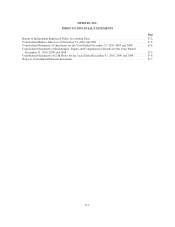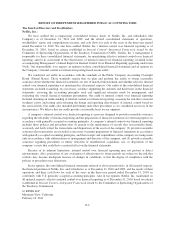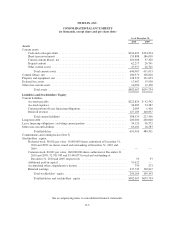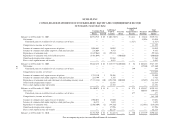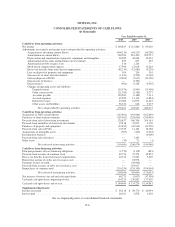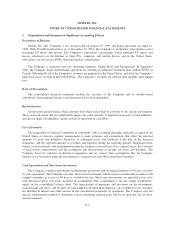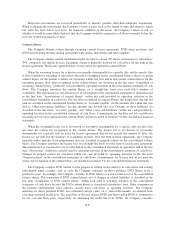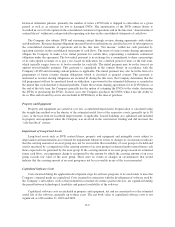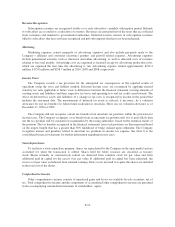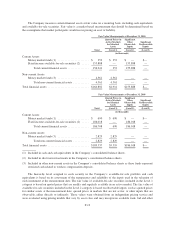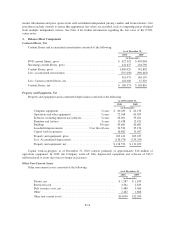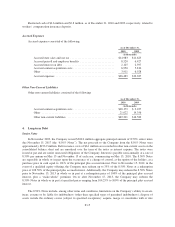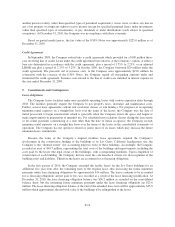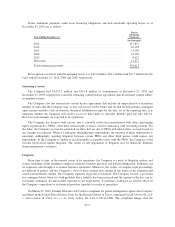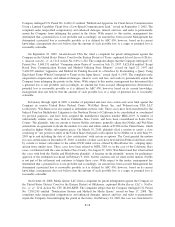NetFlix 2010 Annual Report Download - page 54
Download and view the complete annual report
Please find page 54 of the 2010 NetFlix annual report below. You can navigate through the pages in the report by either clicking on the pages listed below, or by using the keyword search tool below to find specific information within the annual report.Revenue Recognition
Subscription revenues are recognized ratably over each subscriber’s monthly subscription period. Refunds
to subscribers are recorded as a reduction of revenues. Revenues are presented net of the taxes that are collected
from customers and remitted to governmental authorities. Deferred revenue consists of subscriptions revenues
billed to subscribers that have not been recognized and gift subscriptions that have not been redeemed.
Marketing
Marketing expenses consist primarily of advertising expenses and also include payments made to the
Company’s affiliates and consumer electronics partners and payroll related expenses. Advertising expenses
include promotional activities such as television and online advertising, as well as allocated costs of revenues
relating to free trial periods. Advertising costs are expensed as incurred except for advertising production costs,
which are expensed the first time the advertising is run. Advertising expense totaled approximately $212.4
million, $175.0 million and $158.7 million in 2010, 2009 and 2008, respectively.
Income Taxes
The Company records a tax provision for the anticipated tax consequences of the reported results of
operations using the asset and liability method. Deferred income taxes are recognized by applying enacted
statutory tax rates applicable to future years to differences between the financial statement carrying amounts of
existing assets and liabilities and their respective tax bases and operating loss and tax credit carryforwards. The
effect on deferred tax assets and liabilities of a change in tax rates is recognized in income in the period that
includes the enactment date. The measurement of deferred tax assets is reduced, if necessary, by a valuation
allowance for any tax benefits for which future realization is uncertain. There was no valuation allowance as of
December 31, 2010 or 2009.
The Company did not recognize certain tax benefits from uncertain tax positions within the provision for
income taxes. The Company recognizes a tax benefit from an uncertain tax position only if it is more likely than
not the tax position will be sustained on examination by the taxing authorities, based on the technical merits of
the position. The tax benefits recognized in the financial statements from such positions are then measured based
on the largest benefit that has a greater than 50% likelihood of being realized upon settlement. The Company
recognizes interest and penalties related to uncertain tax positions in income tax expense. See Note 8 to the
consolidated financial statements for further information regarding income taxes.
Stock Repurchases
To facilitate a stock repurchase program, shares are repurchased by the Company in the open market and are
accounted for when the transaction is settled. Shares held for future issuance are classified as treasury
stock. Shares formally or constructively retired are deducted from common stock for par value and from
additional paid in capital for the excess over par value. If additional paid in capital has been exhausted, the
excess over par value is deducted from retained earnings. Direct costs incurred to acquire the shares are included
in the total cost of the shares.
Comprehensive Income
Other comprehensive income consists of unrealized gains and losses on available-for-sale securities, net of
tax. Total comprehensive income and the components of accumulated other comprehensive income are presented
in the accompanying consolidated statements of stockholders’ equity.
F-10



